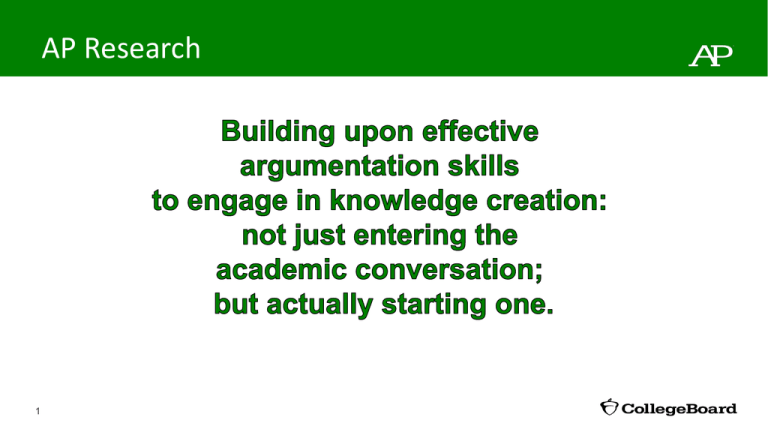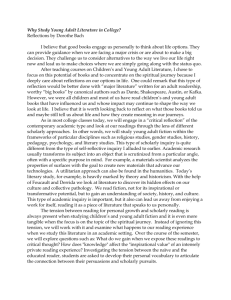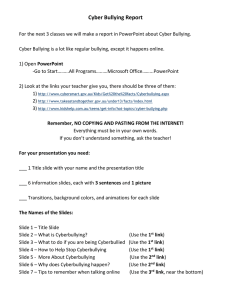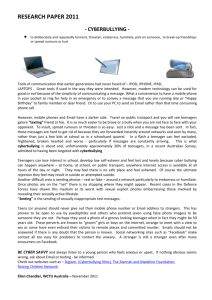AP Research - Spokane Public Schools
advertisement

AP Research 1 AP Research • • • • Design, plan and conduct a year-long research-based investigation on a topic of individual interest in any discipline Demonstrate the ability to apply scholarly understanding to real-world problems and issues Learn and apply research methodologies and employing ethical research practices Access, analyze, and synthesize information to build, present, and defend an argument Assessment Task (Scoring Method) Academic Paper (Teacher-scored; College Board validated) Weight 75% (4,000 - 5,000 words) Presentation and Oral Defense; 15-20 mins. (Teacher-scored) (Optional performance/exhibit shown prior to presentation; 3-4 questions from a panel of three evaluators, one of whom is the AP Research teacher) 2 AP Seminar is a prerequisite to AP Research. 25% Core Skill Area - This year you are supposed to be…. 3 Identifying and Refining Research Questions Narrowing a scope of interest into a research question to serve as the foundation of a long-term investigation or inquiry. Seeking and Synthesizing Background Information Becoming familiar with and synthesizing what others have discovered about the topic so that the scholar can verify the existence of a problem or gap in the knowledge base to form the basis of a long-term investigation. Aligning Study Design Identifying an aligned, feasible research or inquiry design to accomplish the purpose of the research question and/or project goal while taking into consideration time constraints, availability of resources, participant accessibility, and paperwork due to ethics guidelines. Analyzing and Evaluating Findings Interpreting the significance of the findings, results, or product and exploring connections to the original research question and project goal. Engaging with Discipline-Specific Consultants Communicating with experts in the discipline or field of study to obtain guidance and feedback on one’s research question, study purpose, interpretation of findings, or extended piece of scholarly work. Peer Review Providing and receiving timely, constructive feedback according to a set of guidelines in order to improve one’s critical eye and scholarly work Core Skill Areas 4 Showcasing Scholarly Work Conveying a clear message in a way that engages and appeals to a specific audience. Defending Inquiry Outcomes Demonstrating the significance of one’s research by explaining the research process, findings, conclusions, and reflections to those in attendance. Reflecting Making learning goals, assessing one’s achievement toward such goals, and identifying both challenges that hindered and effective strategies that helped one achieve the goals. Strengthening Self- Directedness and Time Management Personally identifying tasks, setting deadlines, and holding oneself accountable to achieve a learning goal or create a scholarly product. Elements of the Paper 5 Required Components of the Presentation and Oral Defense ► ► 15–20 minute presentation (using appropriate media) delivered to an oral defense panel of three evaluators. Oral responses to three or four questions posed by the panel. Three of these questions must be chosen from the oral defense question list (one from each category), which is provided to students in advance: student’s research or inquiry process, ► student’s depth of understanding, ► Student’s reflection throughout the inquiry process as evidenced in his or her process and reflection portfolio (PREP). The fourth question and any follow-up questions are at the discretion of the panel. ► ► 6 Students’ responses to each question should be brief and concise (no more than a few minutes). The Process and Reflection Portfolio (PREP) ► ► 7 The PREP document should address all five big ideas in the curriculum framework (QUEST), with specific attention paid to the following: ► Choice of the research question and interest in the subject matter ► Research process, including resources (documents, people, multimedia); analysis of evidence; directions in which the inquiry or project seems to lead; changes to initial assumptions ► Ways in which students have worked both on their own and as part of a larger community ► Challenges and solutions The PREP is a curricular requirement used to guide the inquiry process and not formally assessed by College Board 7 Differences between AP Seminar and AP Research Paper AP Seminar Paper AP Research Paper AP Research Instructional Strategy Needed * Just an Introduction (Literature Review) Finding gap in knowledge base or your understanding,& situating study question/purpose into this gap. X Method/Process/ Approach Research Methods-overview and rationale for using X Results/Product/Findings How to report findings and connect to research question Discussion/Analysis/ Evaluation How to evaluate significance of results * Conclusion Reflecting on future work only Conclusions/Future Directions *style not Bibliography *Using appropriate style associated with discipline of inquiry introduction of the argument and topic 8 prescribed Transform a Topic of Interest into a Problem Statement ► Identify a controversial issue ► Brainstorm all the components or variables within the issue (including time, place, people, texts, sources, events) ► List two or three components or variables/components that you find interesting about the issue. ► Use the problem statement format to transform the identified issue and associated variables/components into a problem statement 9 Transforming Topics/Problems into Research Questions ► What does it take to transform a topic of inquiry or a problem into a well-defined research question capable of yielding a long-term investigation? ► Let’s transform the bullying study excerpt into a problem statement and then try to transform the problem statement into a research question 10 Finding Problem Statement Examples ► Look through existing scholarly, peer- reviewed articles to find the problem statement. ► Within the problem statement you can see the author’s thought processes in narrowing down the interest in a problem into a focused research question and a method to find answers to the question with a research study. ► Look at the cyberbullying research article excerpt. • Can you find the problem statement format embedded within? • Can you see where the author is leading up to a research question and method to collect data to answer the question? 11 Problem Statements Can Lead to Effective Research Questions ► ► ► ► 13 There is a problem in or with middle school education. Despite efforts to educate middle schoolers on appropriate, safe, and effective uses of technology for learning, cyberbullying is occurring which affects about ten million middle school students each year (Beane, 2008). This problem has negatively impacted 28% of middle school students because many schools decline to discipline off campus behavior. A possible cause of this problem is how to effectively address the ill effects of cyberbullying are complex or unknown. Perhaps a study which investigates the ill effects of cyberbullying and how they were addressed by a mixed method, case study could remedy this situation. From Problem Statement to Research Question ► What are the Ill-effects of Cyberbullying and Associated Punitive Measures Implemented by Four Middle Schools in District XYZ: A Case Study ► Approach-Exploratory ► Design: Non-Experimental ► Method: Qualitative (case study with interviews) 14 Effective Research Question Criteria Emerge from Problem Statement Elements ► Focused Topic: A clear element of the problem or topic of inquiry (cyberbullying, recurring themes of flowers) ► Context: population, place, time, genre (middle school males, Emily Dickenson poetry from 1850-1865) ► Variables/components: components of focused topic to be identified, counted, measured, etc. (punitive measures taken, text used to describe women as flowers) ► Purpose: to explore, explain, or create 15 Writing and Evaluating a Research Question ► ► 16 Use the Student Proposal for Research in the Humanities provided on your worksheet to identify the problem, create a problem statement, and generate a research question associated with this student proposal. Identify the criteria for effective research questions that are embedded in the question you generated. a. Topic, Problem, or Issue: b. Problem Statement: • i. Valuable • ii. Feasible c. Research Question • i. Focused topic • ii. Purpose • iii. Context (Proper Scope) • iv. Variables (Proper Scope) First Attempt: What is the impact of bottled water on the environment? Second Attempt: What is the local environmental impact of the PET recycling habits of XYZ high school students? Revising Research Questions ► ► ► ► ► 18 Identify the strength of the question using the criteria discussed for effective research questions. Revise the question if necessary. Provide rationale for why your revisions make the question more effective than the original version. Be prepared to report your revised question and rationale to the entire class. Use your assigned research question (that your group revised) to develop an associated problem statement. Use the research question you developed for homework (and revised) to develop a problem statement. What purpose does a problem statement serve? First Attempt: What are the causes of cyberbullying by middle schoolers from 2010-2015? Second Attempt: What were the ill-effects of cyberbullying and the punitive measures taken to address cyberbullying at XYZ Middle School from 20102015? To what extent is embedding journalists an ethical and effective way of reporting truth in wartime? fought by American soldiers? To what extent do embedded American journalists affect accuracy of reporting truth of casualties and successes in 21st century wars fought by American soldiers?




